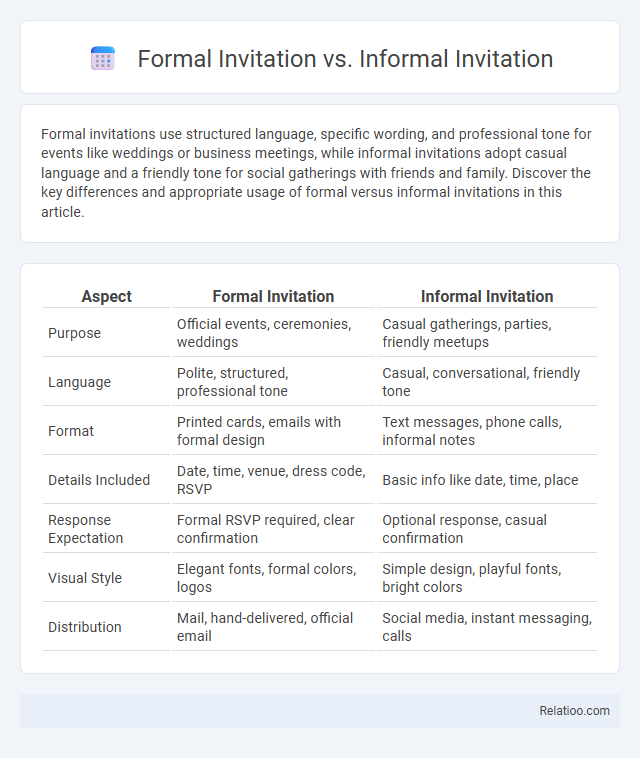Formal invitations use structured language, specific wording, and professional tone for events like weddings or business meetings, while informal invitations adopt casual language and a friendly tone for social gatherings with friends and family. Discover the key differences and appropriate usage of formal versus informal invitations in this article.
Table of Comparison
| Aspect | Formal Invitation | Informal Invitation |
|---|---|---|
| Purpose | Official events, ceremonies, weddings | Casual gatherings, parties, friendly meetups |
| Language | Polite, structured, professional tone | Casual, conversational, friendly tone |
| Format | Printed cards, emails with formal design | Text messages, phone calls, informal notes |
| Details Included | Date, time, venue, dress code, RSVP | Basic info like date, time, place |
| Response Expectation | Formal RSVP required, clear confirmation | Optional response, casual confirmation |
| Visual Style | Elegant fonts, formal colors, logos | Simple design, playful fonts, bright colors |
| Distribution | Mail, hand-delivered, official email | Social media, instant messaging, calls |
Understanding Formal and Informal Invitations
Formal invitations typically feature structured language, clear details, and traditional etiquette, making them ideal for weddings, corporate events, or official ceremonies. Informal invitations use casual language and flexible formats, suitable for personal gatherings like birthday parties or friendly get-togethers. Understanding the distinction between formal and informal invitations helps ensure appropriate tone, clarity, and audience engagement for various occasions.
Key Differences Between Formal and Informal Invitations
Formal invitations typically follow specific etiquette, featuring structured language, clear event details, and often printed on high-quality paper to convey importance and respect. Informal invitations use casual language, can be verbal or digital, and are suitable for relaxed gatherings among friends or family without strict formatting. The key differences lie in tone, presentation, and the nature of the event, with formal invitations reserved for official or significant occasions and informal invitations used for everyday social events.
Purpose and Occasions for Formal Invitations
Formal invitations serve the purpose of conveying respect and seriousness for significant events such as weddings, corporate gatherings, and official ceremonies, ensuring clear communication of essential details and etiquette. Informal invitations are typically used for casual occasions like birthday parties, family get-togethers, or friendly outings, where a relaxed tone and flexible RSVP are appropriate. Your choice of invitation reflects the nature of the event, with formal invitations emphasizing protocol and occasion importance.
When to Use Informal Invitations
Informal invitations are ideal for casual gatherings such as birthday parties, family get-togethers, or friendly social events where a relaxed tone is appropriate. You should use informal invitations when the event does not require strict etiquette or formality, allowing for a warm and personal touch. Unlike formal invitations, which suit weddings or official ceremonies, informal ones emphasize comfort and spontaneity, reflecting a close or intimate atmosphere.
Language and Tone: Formal vs Informal Invitations
Formal invitations use polite, respectful language with structured sentences and proper titles to convey professionalism and importance, while informal invitations adopt casual, conversational tone with colloquial expressions to create a friendly and relaxed atmosphere. Your choice of wording and tone significantly affects the recipient's perception, ensuring clarity and appropriateness based on the event's nature. Understanding these distinctions helps you tailor invitations effectively for weddings, corporate events, or social gatherings.
Essential Elements of a Formal Invitation
A formal invitation typically includes essential elements such as the full names of the host and guest of honor, the specific event details including date, time, and venue, and a clear RSVP request with contact information. Informal invitations are more casual, often using first names, informal language, and may include brief event details without strict formatting. Understanding the distinction between formal and informal invitations ensures appropriate tone and clarity, which is crucial for proper event planning and guest expectations.
Typical Structure of an Informal Invitation
Informal invitations typically feature a casual tone, starting with a friendly greeting followed by a clear mention of the event, date, time, and location, without strict formatting rules. They often include personal touches such as slang, emojis, or handwritten notes to convey warmth and familiarity. Unlike formal invitations that emphasize etiquette and detailed RSVP instructions, informal invitations prioritize simplicity and direct communication, making them ideal for social gatherings among friends and family.
Designing Invitations: Formal vs Informal Styles
Designing invitations involves understanding the distinct characteristics of formal and informal styles to convey the appropriate tone for your event. Formal invitations typically feature elegant fonts, structured layouts, and refined language to reflect sophistication, while informal invitations embrace playful designs, casual wording, and vibrant colors for a relaxed vibe. By tailoring your invitation design to suit the occasion, you ensure your guests instantly grasp the event's ambiance and your thoughtful planning.
Etiquette Rules for Sending Invitations
Formal invitations require strict adherence to etiquette rules such as including full names, titles, and RSVP details, often printed on high-quality stationery and sent well in advance. Informal invitations allow for more casual language, flexible formats like digital messages, and may be sent closer to the event date, catering to a familiar audience. Understanding the distinction between formal and informal invitations is crucial in selecting appropriate wording, timing, and presentation for the event's tone and guest expectations.
Choosing the Right Invitation for Your Event
Choosing the right invitation for your event depends on the occasion's tone and formality; formal invitations, often printed on high-quality paper with elegant wording, suit weddings, galas, and corporate events. Informal invitations, which can be digital or handwritten, are perfect for casual gatherings like birthday parties or relaxed get-togethers, offering a personal and approachable feel. Understanding the nature of your event will help you decide whether a traditional formal invite or a laid-back informal message best reflects your intentions and ensures clear communication with your guests.

Infographic: Formal Invitation vs Informal Invitation
 relatioo.com
relatioo.com